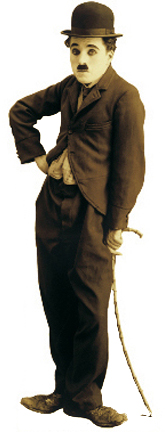Play The Movie
by James Tighe – from The Local Voice #147
It’s no secret that movies are considered the ascendant art form today. And not just in terms of popularity. Certainly novelists can learn from some of the take-no-prisoners scripts now being written for the screen. Make no mistake: the literary ante has been upped considerably by the quality of today’s screenplays, even if written by committee.
The degree of change movies underwent when they moved from silent pictures to talkies in the late 20s was amazing. I know this sounds obvious. But the difference in the narrative depth and range of the early 30s’ films from the silents and the speed with which this happened was so dramatic.
Chaplin, who bemoaned the advent of sound in the movies until the day he died, pointed out at the time that talking motion pictures would deprive films of their universality. In the teens and 20s Chaplin’s films were as popular in Buenos Aires and Paris as they were in New York City. Subtitles are still trying to bridge the gap.
Once actors began to speak in films, the Hollywood studios hired playwrights, newspaper reporters, novelists—professional writers—who supplied instant narrative sophistication. Almost immediately the great films of the 30s raced to catch up to the imaginative landscapes of novels and the theater. This is not to say the new talkies were better than the silents. There is a case to be made that something unique was lost forever when the silent motion pictures went by the boards. How can anyone argue against the achievements of Chaplin and Lloyd and Sennett and Keaton and Stan Laurel and Oliver “Babe” Hardy?
A big part of the appeal of so many of the best films of the 30s and 40s and early 50s—turned out by the often maligned studio system—was their unpretentiousness. The actors often delivered their lines quickly, with what seems now a refreshing unselfconsciousness (Cagney, Lombard, E.G. Robinson, Bogart), devoid of Shakespearean overtones, letting the words speak for themselves. The director’s palette was that of black and white cinematography, which consisted of an infinite number of mysterious and timeless shades and tones that contributed enormously to the enduring quality of these films. And they usually ran for a forgiving ninety minutes. Are there two more dreadful words in the English language than “director’s cut”?
Movies from non-European countries have begun to take their place among, as well as surpass, American and European films. In part this is a pure numbers game. Nonetheless, world-class motion pictures are being exported by Argentina (Son of the Bride), Columbia (The Wind Journey), Brazil (Central Station), China (Xiu Xiu), Mexico (The Violin), the list goes on and on.
For a long time I’ve felt British film-making in the late 50s and early 60s was unfairly made to take a back seat, by critics, to the French New Wave and Italy’s Neo-realism at the time. I’ll stack the British trilogy of Billy Liar, Loneliness of the Long Distance Runner, and Saturday Night and Sunday Morning against anything being produced on the Continent back then. Likewise, the films of British directors Michael Powell, Carol Reed, and Anthony Asquith take a back seat to nobody. (And I’m no Anglophile.) The films of these men are to be contrasted, perhaps unfairly, with such ghastly British pictures of late, as Shakespeare in Love and The English Patient, and the more recent revisionist English films attempting to portray various members of the Royal Family past and present as if they were human beings.
It must be said that the British Isles produce the best actors in the world, especially of the character-actor variety. American actors, I’m sorry to say, can’t hold a candle to our eastern Atlantic cousins.
I’ve long been intrigued by the differences in American and European movie-making. American movies, in the main, favor a linear, conventional novelistic approach to narrative. European films over the years seem to be more circus-like, more serendipitously episodic. I’m not saying one is better than the other. There’s more than one way to skin a cat. I also welcome the Europeans’ embrace of the tragi-comic (Italy’s The Starmaker), as opposed to our current predisposition for mindless, sophomoric, lowest-common-denominator comedies. (Woody Allen’s Vicky Cristina Barcelona an exception.)
I also wonder what European film history would be like without the inexhaustible subject of the Second World War. This point was addressed by the Wise Man when he was asked why evil had been introduced in the world? “To thicken the plot,” he said.
James Tighe is a writer who lives in Oxford, Mississippi.


